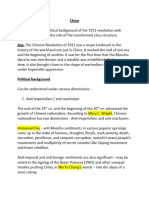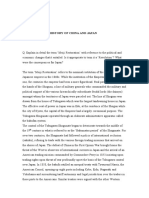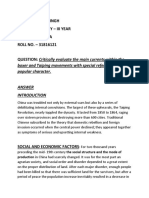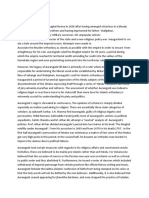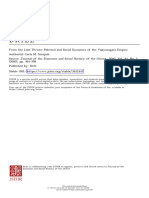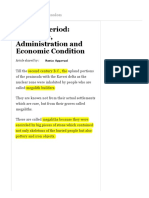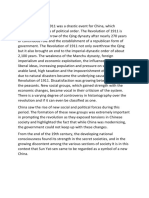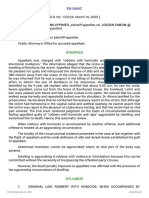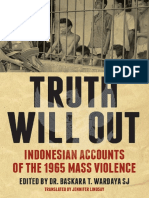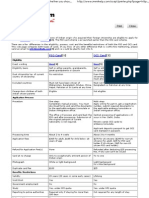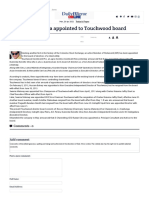Professional Documents
Culture Documents
Annexation of Lushai Hills
Annexation of Lushai Hills
Uploaded by
Gino RalteCopyright
Available Formats
Share this document
Did you find this document useful?
Is this content inappropriate?
Report this DocumentCopyright:
Available Formats
Annexation of Lushai Hills
Annexation of Lushai Hills
Uploaded by
Gino RalteCopyright:
Available Formats
THE ANNEXATION OF THE LUSHAI HILLS
or
CONSOLIDATION OF THE BRITISH IN LUSHAI HILL
or
THE BRITISH RELATIONS WITH LUSHAI HILLS
Miss Vari
The Mizo are of Mongoloid stock that migrated through the Chin Hills of
Burma to their present habitat in around 1700 AD. They were first known by the
outsiders for their savagery and referred by head taking traditions. Inter -clan rivalry
prevails and several raids on other villages were a frequent occurrence. Besides, they
often raid the people in the adjoining plain areas, looting, killing and capturing them,
especially the tea gardens because they felt was an encroachment upon their hunting
ground. This stirred up the attention of the British to take action by subjugating the
Lushai Hills to protect their interests in Cachar and Chittagong as well as Upper
Burma.
THE LUSHAI RAIDS:
Since the annexation of Cachar by the British in 1832, the local authorities had
to deal with the incursions of the Lushai tribes in the south. There were frequent
attacks made by the Lushais in the middle of the 19th Century. The main causes of
these raids were gradual extension of tea gardens into areas inhabited by the Lushais,
raid for food and also native daring and spirit of adventure on the part of the Lushais.
From time to time, the Lushai raids the plains of Cachar which later shaped the
frontier policies of the British over the Lushais.
The Lushai raid to Kochabari village in Cachar plain on 16th April 1844
resulted to the death of 20 persons and 6 persons in captive and it attracted a punitive
expedition in December 1844 under Captain Blackwood. The expedition resulted in
punishing the Lushai chiefs Lalsuthlaha, who committed a raid on the Sylhet frontier.
As the raids continued, the Bengal government directed Col Lister, Superintendent of
Cachar to punish the aggressors. Accordingly, on 14th January 1850, Lt Col Lister,
Commandant of the Sylhet Infantry and Agent for the Khasi Hills marched towards
the village of Ngura and burnt the village and released several of British subjects in
captivity.
As the British government realized that retaliatory measures could not
effectively check the Lushais from incursions, they decided to adopt conciliatory
measures and sent goodwill mission to several Lushai chiefs like Vanhnuailiana,
Suakpuilala etc. But the policy proved unsuccessful in the long run. In January 1869,
the tea estate of Monierkhal in Cachar was jointly raided by Kanai Singh, a Manipuri
Prince and Suakpuilala. For some years, they were raids and counter-raids.
THE LUSHAI EXPEDITION:
On 27th January 1870, to give an instance, the Mizos under Bengkhuaia raided
Alexandrapur and Monierkhal. This incident affected the history of the Lushai hills
profoundly. They killed James Winchester, a Scottish Tea planter along with 24
coolies and abducted several British subjects including his 5 years old daughter Mary
Winchester. The feeling aroused by Mary Winchester’s kidnapping compelled the
British government to make strenuous effort to release the captive girl. Even though
the initial British policy towards the North eastern state was that of Non-intervention,
and though the government wanted to adhere to its policy of conciliation, ultimately
issued an order for an expedition into the Lushai hills. It was to rescue the captive girl
and to enter into permanent relationship with the Lushais that a military expedition
was launched in the cold season of 1871 by order of Lord Mayo, the Governor-
General of India. This expedition was known as ‘The Lushai Expedition’.
The Right or the Chittagong Colum under General Brownlow compelled the
powerful Bengkhuaia, Savunga and others to tender their submission, release the
captives including Mary Winchester and the Left or the Cachar Column under General
Bourchier subdued the tribes of Vanpuilala, Pawibawia,Vanhnuailiana. The principal
Lushai chiefs personally tendered their submission and entered into solemn
engagement with the British for further good behaviour. The aim of the expedition
was neither annexation nor retaliation but to strengthen the policy of conciliation.
Though peace had been made, many people especially the Lushai chiefs
resented new restraints laid on them. They dislike, above all, the fact that no Mizo was
allow to go outside his territory. Soon they began to raid the plain areas again. On 3rd
February 1889, a survey party under Lt. Stewart was stormed by Hausata and his
party, killing Lt. Stewart and two European Sergeants. The fresh outrages made it
necessary that active measures should be immediately undertaken.
THE CHIN LUSHAI EXPEDITION:
In 1889-1890, the larger expedition known as ‘The Chin Lushai Expedition’
was launched under F.W Treager. The main objectives of the expedition were to come
to terms with certain Lushai tribes who were powerful and hostile to the British, to
open the route between Burma and Chittagong, to establish semi- permanent posts in
the region visited and to ensure complete pacification and recognition of the British
power.
The three Columns - Chittagong, Cachar and Burma successfully carried out
the main objects of the campaign and resulted in the subjugation of many villages,
burning of several villages, and construction of Mule road connecting India and
Burma and establishment of several posts. The expedition finally marked the
beginning of the British rule in Lushai hills and it was formally brought into British
India by a proclamation in 1895. Since then, the British had established themselves as
the paramount power in the hills.
ADMINISTRATIVE SETUP OF THE BRITISH
The Chin Lushai Expedition led to the establishment of four garrison posts at
Demagiri, Aijal, Lungleh and Fort Treager for the preservation of order and as
evidence of British supremacy. In 1890 whole of Lushai hills was divided into North
Lushai Hills and South Lushai Hills districts under the administration of Assam and
Bengal repectively. Political Officers were posted both at Aijal and Lungleh. The first
Political Officer of the Lushai Hills was Capt HR Brown. The administration of the
Northern part which had headquarters at Aijal went to the Commissioner of Assam
while the southern portion was administered by the Lt. Governor of Bengal with
Murray as the first political officer. The British even called for a Chin-Lushai
Conference in Calcutta in 1892 in which several Lushai chiefs participated. By 1895-
86, J. Shakespear, the Superintendent reported that the Lushais in the southern hills
have completely abandoned all ideas of resistance and such was also the case in the
northern hills.
On 1st April 1898, the two districts were amalgamated into one administrative
unit known as the Lushai Hills District under the Commissioner of Assam with Aijal
as the Headquarters with Capt. J. Shakespeare as the first superintendent of the
amalgamated Lushai Hills. Under the supervision of the Chief Commissioner of
Assam, Inner-Line Regulation was brought into force to check the infiltration of the
outsiders. Later, The Lushai Hills District was changed to Mizo District by an Act
called the “Lushai Hills District Act, 1954 with effect from 1st September 1954.
You might also like
- Law Enforcement Organization and AdministrationDocument51 pagesLaw Enforcement Organization and AdministrationJohnpatrick Dejesus67% (3)
- A Brief History (Puwari) of The Meiteis of ManipurDocument10 pagesA Brief History (Puwari) of The Meiteis of ManipurEl BiswajitNo ratings yet
- History of Archaeological Survey of India PDFDocument7 pagesHistory of Archaeological Survey of India PDFरवि शंकर50% (2)
- Hema Malini RapeDocument17 pagesHema Malini Rapevayave33% (3)
- May 4th MovementDocument8 pagesMay 4th MovementShreyashi KashyapNo ratings yet
- History of Modern ChinaDocument5 pagesHistory of Modern ChinaAditya SinghNo ratings yet
- Opium WarDocument11 pagesOpium Warapi-316637313No ratings yet
- 1911 RevolutionDocument8 pages1911 RevolutionKusum KumariNo ratings yet
- Gupta AdministrationDocument3 pagesGupta AdministrationNipun MudgalNo ratings yet
- Name - Arshita Kanodia Class - History (Hons) 3 Year Roll No - 45Document5 pagesName - Arshita Kanodia Class - History (Hons) 3 Year Roll No - 45Arshita KanodiaNo ratings yet
- Mansabdari System of AkbarDocument4 pagesMansabdari System of AkbarAarush RajputNo ratings yet
- Economy and Administration of Mauryan EmpireDocument5 pagesEconomy and Administration of Mauryan EmpireMayukh NairNo ratings yet
- Aspects of Bhakti Movement in India: TH THDocument10 pagesAspects of Bhakti Movement in India: TH THchaudhurisNo ratings yet
- Different Schools of Thought #SPECTRUMDocument8 pagesDifferent Schools of Thought #SPECTRUMAditya ChourasiyaNo ratings yet
- Theories of Imperialism IlllDocument22 pagesTheories of Imperialism IlllAnushree DeyNo ratings yet
- A. Bhattacharya - The Boxer Rebellion I-1Document20 pagesA. Bhattacharya - The Boxer Rebellion I-1Rupali 40No ratings yet
- Historiographies On The Nature of The Mughal State: Colonialsist HistoriographyDocument3 pagesHistoriographies On The Nature of The Mughal State: Colonialsist Historiographyshah malikNo ratings yet
- Ignou Course On The Most Populous Country in The WorldDocument14 pagesIgnou Course On The Most Populous Country in The WorldAmit100% (1)
- First Opium WarDocument5 pagesFirst Opium WarNishita SindhuNo ratings yet
- Satavahana AdministrationDocument1 pageSatavahana AdministrationnitakuriNo ratings yet
- Different Nationalist Approaches of Indian HistoryDocument6 pagesDifferent Nationalist Approaches of Indian HistoryLast RoninNo ratings yet
- Can The Revolt of 1857 Be Described As A Popular Uprising? CommentDocument5 pagesCan The Revolt of 1857 Be Described As A Popular Uprising? CommentshabditaNo ratings yet
- Later Vedic SocietyDocument6 pagesLater Vedic SocietyHidayath UllahNo ratings yet
- Santal HoolDocument6 pagesSantal HoolMaroona MurmuNo ratings yet
- 265693150Document8 pages265693150Chitra RajpalNo ratings yet
- Monotheistic Movements in North IndiaDocument3 pagesMonotheistic Movements in North Indiaaryan jainNo ratings yet
- Assignments On Taiping Final VersionDocument4 pagesAssignments On Taiping Final VersionshinexixiNo ratings yet
- Bhakti MovementDocument4 pagesBhakti MovementAnvesha VermaNo ratings yet
- Canton SystemDocument11 pagesCanton SystemLalit DhakerNo ratings yet
- Revolution Demise Shogunate Edo (Tokugawa) Period Meiji ContextDocument7 pagesRevolution Demise Shogunate Edo (Tokugawa) Period Meiji ContextmanyaNo ratings yet
- Left Movement in India:: Pre - Independence Phase !!Document3 pagesLeft Movement in India:: Pre - Independence Phase !!Mahesh KumarNo ratings yet
- Nayaka Syatem and Agrarian SetupDocument3 pagesNayaka Syatem and Agrarian SetupPragati SharmaNo ratings yet
- Meiji RestorationDocument11 pagesMeiji RestorationNeelamNo ratings yet
- Swadeshi and RevolutionaryDocument5 pagesSwadeshi and RevolutionaryNoor ChahalNo ratings yet
- South India UrbanisationDocument5 pagesSouth India Urbanisationpriyalnaik.15No ratings yet
- Assignment 3 The Glorious RevolutionDocument4 pagesAssignment 3 The Glorious RevolutionVictoria FajardoNo ratings yet
- Ashoka and His DhammaDocument11 pagesAshoka and His DhammaAkash TiwariNo ratings yet
- Suhungmung As One of The Greatest Ahom KingsDocument8 pagesSuhungmung As One of The Greatest Ahom KingsNandita Das100% (1)
- (B) Taiping and Boxer Movements - Causes, Ideology, NatureDocument7 pages(B) Taiping and Boxer Movements - Causes, Ideology, Natureinsha moquitNo ratings yet
- Background and Causes of The Revolution of 1911Document6 pagesBackground and Causes of The Revolution of 1911Kusum KumariNo ratings yet
- Mrigavati by Shakya Qutban SuhrawardiDocument2 pagesMrigavati by Shakya Qutban SuhrawardiEshaa JainNo ratings yet
- Historiography of Delhi SultanateDocument22 pagesHistoriography of Delhi SultanateKundanNo ratings yet
- Silence Revealed Womens - Experiences - DuriDocument14 pagesSilence Revealed Womens - Experiences - DurismrithiNo ratings yet
- Tribal Politics in The Assam 1933-1947Document9 pagesTribal Politics in The Assam 1933-1947জ্যোতিৰ্ময় বসুমতাৰীNo ratings yet
- The British Annexation of CacharDocument3 pagesThe British Annexation of CacharEmily Grace Mukhim100% (1)
- History of China - (Assignment)Document12 pagesHistory of China - (Assignment)sugam sehrawatNo ratings yet
- Aurangzeb State and Religion AssignmentDocument4 pagesAurangzeb State and Religion AssignmentAnonymous sZgomQn5jKNo ratings yet
- From The Lion Throne: Political and Social Dynamics of The Vijayanagara EmpireDocument36 pagesFrom The Lion Throne: Political and Social Dynamics of The Vijayanagara Empirearijeet.mandalNo ratings yet
- GENDER - Trends of Feminist Historiography Modern IndiaDocument3 pagesGENDER - Trends of Feminist Historiography Modern IndiasmrithiNo ratings yet
- Sangam Period - Literature, Administration and Economic ConditionDocument23 pagesSangam Period - Literature, Administration and Economic Conditionavinash_formalNo ratings yet
- Religion & Religiosity Assignment-1Document9 pagesReligion & Religiosity Assignment-1Shambhavi YadavNo ratings yet
- Taiping Rebellion - IgnouDocument14 pagesTaiping Rebellion - IgnouNikunj GoelNo ratings yet
- 1911 Revo AnsDocument9 pages1911 Revo Ansvaishnavi thakurNo ratings yet
- 10 HarrisonDocument16 pages10 HarrisonYuvraaj KapoorNo ratings yet
- 11 - Chapter 3 PDFDocument55 pages11 - Chapter 3 PDFBHFkonyvtarNo ratings yet
- Military Modernization of JapanDocument10 pagesMilitary Modernization of JapanRamita UdayashankarNo ratings yet
- Ashoka Empire EssayDocument7 pagesAshoka Empire EssaySUNYYRNo ratings yet
- Evolution of Vernacular LangauagesDocument43 pagesEvolution of Vernacular LangauagesShakuntala PetwalNo ratings yet
- Muhammad Ali Qureshi and Hasan Raza: NamesDocument16 pagesMuhammad Ali Qureshi and Hasan Raza: NamesTanishq MalhotraNo ratings yet
- Firoz Shah Tughlaq's AdministrationDocument22 pagesFiroz Shah Tughlaq's AdministrationSarthak Jain0% (1)
- Melencio Vs CA, GR 148846, Sept 25, 2007Document2 pagesMelencio Vs CA, GR 148846, Sept 25, 2007Samantha LiNo ratings yet
- World 6,363,196 +103,946 377,190 +3,053 2,900,380 3,085,626 53,407 816 48.4Document11 pagesWorld 6,363,196 +103,946 377,190 +3,053 2,900,380 3,085,626 53,407 816 48.4Hoppie PittisNo ratings yet
- Connectors ExercisesDocument3 pagesConnectors ExercisesCesar Sigala'No ratings yet
- 112 - Islamic Way of Life 2Document37 pages112 - Islamic Way of Life 2Innocent KuriNo ratings yet
- Jadwal KBM Semester Ganjil 2023-2024 Revisi 240723Document11 pagesJadwal KBM Semester Ganjil 2023-2024 Revisi 240723Septian RahmadNo ratings yet
- People vs. FabonDocument13 pagesPeople vs. FabonZoe Kristeun GutierrezNo ratings yet
- Sectarian Politics in Pakistani Punjab A PDFDocument107 pagesSectarian Politics in Pakistani Punjab A PDFtalha khanNo ratings yet
- Allan NairnDocument55 pagesAllan NairngpouladosNo ratings yet
- 10 Common Hand Signals in Basketball OfficiatingDocument7 pages10 Common Hand Signals in Basketball OfficiatingMa. Concepcion DesepedaNo ratings yet
- Peer Pressure Inventory PDFDocument4 pagesPeer Pressure Inventory PDFjosef mercadoNo ratings yet
- PCPNDT CasesDocument22 pagesPCPNDT CasesSwati SharmaNo ratings yet
- Tataelxsi 10122020194348 Se IrDocument2 pagesTataelxsi 10122020194348 Se Irv pavanNo ratings yet
- New Haven Final CompStat Weekly Report - JUN 28 - JUL 4 2021Document31 pagesNew Haven Final CompStat Weekly Report - JUN 28 - JUL 4 2021Helen BennettNo ratings yet
- Utopia Thomas MoreDocument5 pagesUtopia Thomas MoreAura ŞtefănescuNo ratings yet
- Truth Will OutDocument226 pagesTruth Will OutAbraham UtamaNo ratings yet
- Countering Criminal Street Gangs: Lessons From The Counterinsurgent BattlespaceDocument10 pagesCountering Criminal Street Gangs: Lessons From The Counterinsurgent BattlespaceJohn A. Bertetto100% (1)
- History of British Isles (1 Great Britain)Document85 pagesHistory of British Isles (1 Great Britain)Montaño Marcovich Daniel100% (1)
- Burke and PaineDocument7 pagesBurke and PaineGilbert KirouacNo ratings yet
- Police Professionalism in The People's Republic of ChinaDocument2 pagesPolice Professionalism in The People's Republic of ChinacallicopellaNo ratings yet
- Warranty Form (1688)Document2 pagesWarranty Form (1688)Debbie ButtonNo ratings yet
- ActivityDocument2 pagesActivitysheryl ann dionicioNo ratings yet
- OCI Vs PIO CardDocument3 pagesOCI Vs PIO CardabspandeyNo ratings yet
- Key Word Transformations 1Document11 pagesKey Word Transformations 1pm.vittomasseiNo ratings yet
- Ike Perlmutter Motion, Part 2Document35 pagesIke Perlmutter Motion, Part 2Law&CrimeNo ratings yet
- Adolf 20 CenturyDocument1 pageAdolf 20 CenturySans RecourseNo ratings yet
- E8 Agabon V NLRC (Statutory Due Process)Document5 pagesE8 Agabon V NLRC (Statutory Due Process)MarkNo ratings yet
- Daily Mirror - MP Duminda Silva Appointed To Touchwood BoardDocument4 pagesDaily Mirror - MP Duminda Silva Appointed To Touchwood BoardManagment TrainingNo ratings yet







